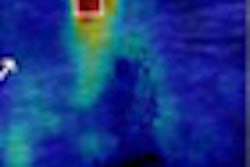If you're interested in a low-cost substitute for ultrasound gel, hand sanitizer works very well, according to a presentation last month at the American Institute of Ultrasound in Medicine (AIUM) annual meeting in New York City.
Emergency medicine physicians and sonographers from the University of California, San Diego conducted the Ultrasonographic Study of Alternative Gel Experimental Substances (USAGES) to see if a cheaper alternative to ultrasound gel could be found. Such an alternative could be a boon in developing countries where radiology budgets are tight.
Researchers examined six common household liquid products, using them with an ultrasound scanner to see if they produced images of clinical quality and diagnostic utility. They enrolled a group of healthy adult volunteers who underwent types of ultrasound exams frequently ordered by emergency department physicians.
The sonographic images were of the right upper quadrant, subxiphoid, left upper quadrant, bladder, aorta, and right lung, as well as right internal jugular vein views to verify central line insertion.
An emergency department sonographer who was fellowship-trained in ultrasound obtained the images. She was not allowed to see or smell any of the substances used in the prospective study. The products used included baby shampoo, hairstyling gel, hand lotion, hand sanitizer, liquid dishwashing detergent, and olive oil.
A total of 189 images were obtained from 27 exams. The images were evaluated by two blinded emergency sonographers who were certified in ultrasound image interpretation, along with a board-certified radiologist. Each was asked to assess and rank both image quality and clinical utility on a scale of 1 to 10.
Prior to starting USAGES, the researchers had each of the image reviewers rate a set of ultrasound images of varying quality that had been conventionally acquired. They were asked to numerically rank the images and advise if they met a threshold of minimal acceptable quality. Acceptable quality for the two ED physicians and the radiologist was a rank of 8 or higher.
Session presenter Dr. Davut Savaser, an attending ED physician and a clinical instructor in emergency medicine, said that all 189 images received a score of 8 or higher by all reviewers. The hand sanitizer scored the best, at a median of 9.2, followed by the hairstyling gel and olive oil at 8.9. The images acquired with ultrasound gel were rated at 9.6.
"All of these, even the baby shampoo, which scored lowest at a rank of 8.2, can be used as a cheap alternative for ultrasound gel for many types of ultrasound exams," he said. "Ultrasound gel costs about 35¢ an ounce. Everything else we tested costs about half that."
Savaser said the use of hand sanitizer could be helpful in clinics and hospitals in developing countries, but that it needs to be evaluated for patient safety.
"For procedural ultrasounds, more information needs to be obtained about alternative gel safety for specific procedures, such as gallbladder/abdominal or lung exams," he said. "I don't recommend anything but ultrasound gel for ocular ultrasound exams, endocavitary exams, or any exam that involves exposure to a mucous membrane or human orifice."
The use of hand sanitizer or another alternative gel also has to be evaluated regarding probe safety. One session attendee said that mineral oil was used years before, but it eventually destroyed transducers. The research team did check with the probe manufacturer to verify that the six alternative gels were safe to use with the equipment.
The researchers are considering a much larger study to determine the viability of using these cheaper alternatives.
"The comparable image quality obtained is the most compelling observation for the study," Savaser told AuntMinnie.com. "Our research may benefit hospitals with very limited funds for medical supplies in other countries of the world."



















